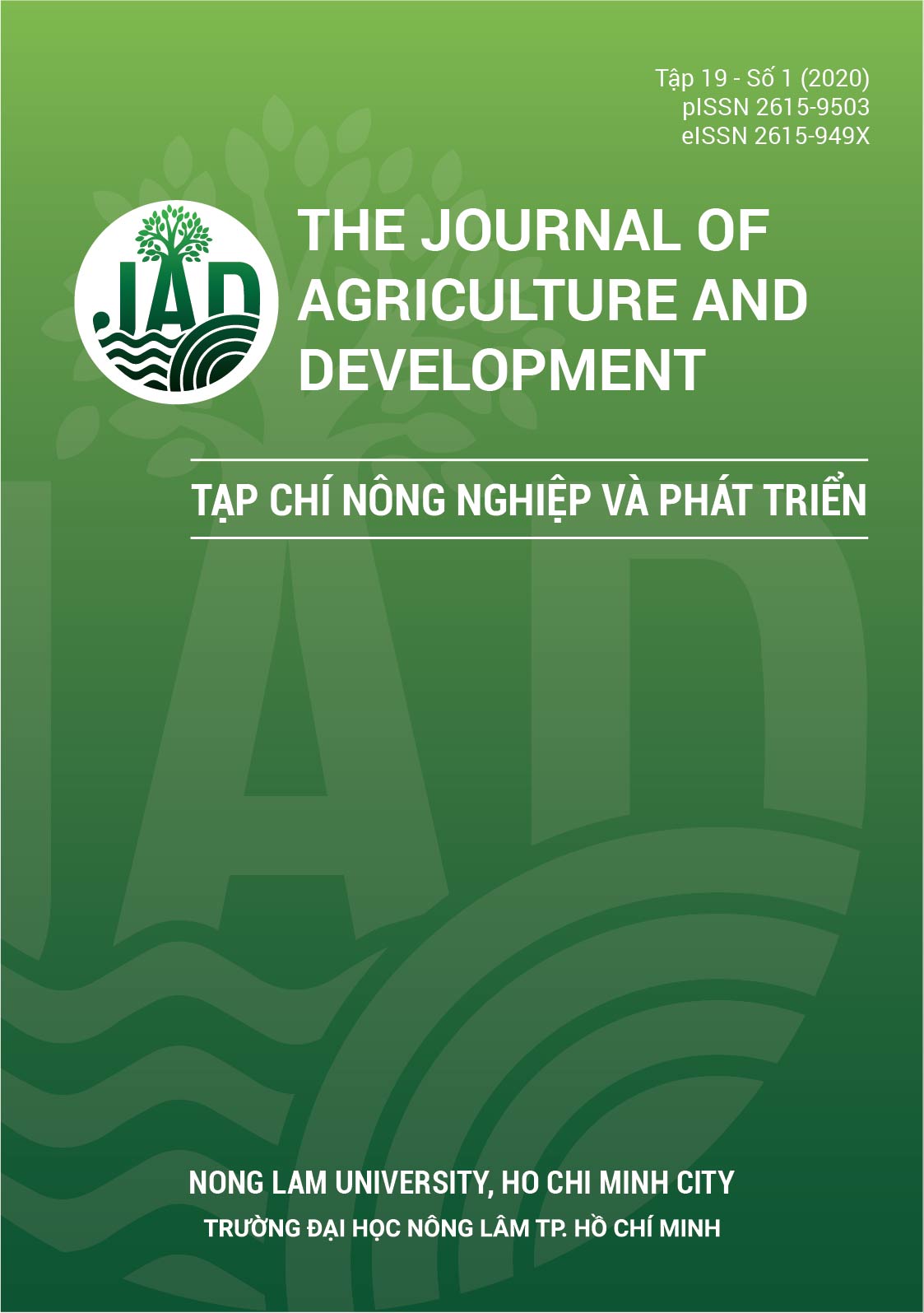Rearing white leg shrimp larvae (Litopenaeus vannamei Boone, 1931) with concentrated diatom (Thalassiosira sp.)
Main Article Content
Abstract
The objective of the experiment was to determine the best type of algae for growth, survival rate and the metamorphosis time of white leg shrimp larvae. The experiment consisted of five treatments: dried Spirulina sp. (NT 1), fresh Chaetoceros sp. (NT 2), fresh Thalassiosira sp. (NT 3), Thalassiosira sp. in concentrated form (NT 4) and Thalasiosira sp. in paste form (NT 5). The larvae at Nauplius VI were stocked in 0.5 m3tank at the stocking density of 200 inds/L. The care regime was applied according to the popular process at the National Breeding Center for Southern Marine Aquaculture. After 10 days of stocking, the water parameters in all treatments were in a suitable range for the growth of larvae. The larvae in NT 4 showed the best body length, survival rate, metamorphosis time and were significant difference compared to the remaining treatments (P < 0.05). Whereas NT 5 was not significantly different (P > 0.05) compared to NT 2 in body length and NT 3 in metamorphosis time. NT 1 showed the worst these characteristics to the other treatments. In general, the use of concentrated Thalassiosira sp. for rearing white leg shrimp larvae gives good results, which should be commonly applied.
Article Details
References
Ashashalini, A., Syed, A., Anuradha, V. M., Yogannanth, N., Suganya, V., & Bhuvana, P. (2018). Cultivation, Quantification and Pharmacognostic Study of methanolic extract of Thalassiosira sp.. Journal of Pharmacy 8(10), 36-43.
FAO (Food and Agriculture Organization of The United Nations. (2003). Health management and biosecurity maintenance in white shrimp (Penaeus vannamei) hatcheries in Latin America. Retrieved August 25, 2019, from http://www.fao.org/3/y5040e/y5040e00.htm#Contents.
FISTENET (Directorate of Fisheries). (2019). The conference discussed solutions to manage marine shrimp breeds. Retrieved August 28, 2019, from https://www.fistenet.gov.vn/News/hoi-nghi-ban-cac-giai-phap-quan-ly-giong-tom-nuoc-lo.
Iba, W., Rice, M. A., & Wikrors G. H. (2014). Microalgae in Eastern Pacific white shrimp, Litopenaeus vannamei (Boone 1931) Hatcheries: A Review on roles and culture environments. Asian Fisheries Society 27(2014), 212-233.
ISC (Invasive Species Compendium). (2019). Litopenaeus vannamei (white leg shrimp). Retrieved August 25, 2019, from https://www.cabi.org/isc/datasheetC880.
Kiatmetha, P., Siangdang, W., Bunnag, B., Senapin, S., & Withyachumnarnkul, B. (2010). Enhancement of survival and metamorphosis rates of Penaeus monodon larvae by feeding with the diatom Thalassiosira sp.. Aquaculture International 19(4), 599-609. https://doi.org/10.1007/s10499-010-9375-y
Ly, K. V., Vo, S. N., Pho, N. V., & Tran, H. N. (2015). The current status of technique and finance in the seed production of whiteleg shrimp in the Mekong Delta. Can Tho University Journal of Science 39, 108-117.
Ngo, T. A., & Trinh, L. V. (2009). Research on broodstock culture and artificial reproduction of white leg shrimp (Penaeus vannamei Boone, 1931) in Khanh Hoa. Journal of Fisheries Science and Technology, 40-48.
Pablo, P., Mario, N., Luis, R., Cesar, C. O., & Domenico, V. (2005). Survival, growth and feeding efficiency of Litopenaeus vannamei protozoa larvae fed different rations of the diatom Chaetoceros muelleri. Aquaculture 249, 431-437.
Palacios, E., Racotta, I. S., Heras, H., Marty, Y., Moal, J., & Samain, J. F. (2001). Relation between lipid and fatty acid composition of eggs and larval survival in white pacific shrimp (Penaeus vannamei, Boone, 1931). Aquaculture 9, 531-543. https://doi.org/10.1023/A:1020589924810
Pratoomyot, J., Srivilas, P., & Noiraksar, T. (2005). Fatty acids composition of 10 microalgal species. Songklanakarin Journal of Science and Technology 27(6), 1179-1187.
Sangha, R. S., Cruz, A. C. P., Chavez-Sanchez, M. C., & Jones, D. A. (2000). Survival and growth of Litopenaeus vannamei (Boone) larvae fed a single dose of live algae and artificial diets with supplements. Aquaculture Research 31, 683-689. https://doi.org/10.1046/j.1365-2109.2000.318487.x








